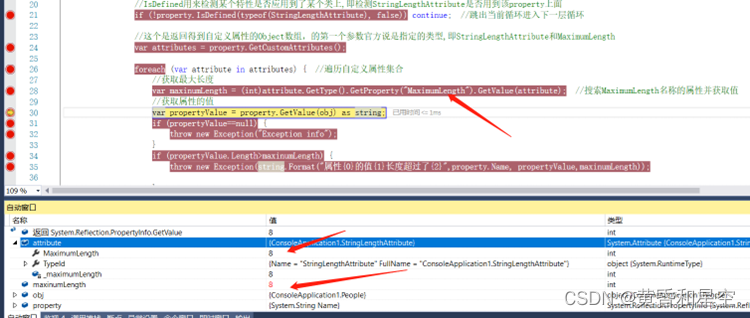本文讲解 C#程序设计Attribute特性的概念和用法。
- 操作流程 1.1. Attribute概念 1.1.1. 概念 属性(Attribute)是C#程序设计中非常重要的一个技术,应用范围广泛,用法灵活多变。本文就以实例形式分析了C#中属性的应用。 1.1.2. 运用范围 程序集,模块,类型(类,结构,枚举,接口,委托),字段,方法(含构造),方法,参数,方法返回值,属性(property),Attribute
1.2. 自定义Attribute 1.2.1. 自定义一个检查字符串长度的Attribute 为了符合“公共语言规范(CLS)”的要求,所有的自定义的Attribute都必须继承System.Attribute。 第一步:自定义一个检查字符串长度的Attribute
AttributeUsage这个系统提供的一个Attribute,作用来限定自定义的Attribute作用域,这里我们只允许这个Attribute运用在Property上,内建一个带参的构造器,让外部传入要求的最大长度。 AttributeUsage AttributeTargets在C#的类中,有的类加上了[AttributeUsage(AttributeTargets.Property)]这个是起什么作用的呢?AttributeTargets 枚举
1.2.2. 创建一个实体类来运行自定义的属性
定义了两个字符串字段Name和Description, Name要求最大长度为8个,Description要求最大长度为15. 1.2.3. 创建验证的类 public class ValidationModel {
public void Validate(object obj) { var t = obj.GetType();
//由于我们只在Property设置了Attibute,所以先获取Property
var properties = t.GetProperties();
foreach (var property in properties)
{
//这里只做一个stringlength的验证,这里如果要做很多验证,需要好好设计一下,千万不要用if elseif去链接
//会非常难于维护,类似这样的开源项目很多,有兴趣可以去看源码。
if (!property.IsDefined(typeof(StringLengthAttribute), false)) continue;
var attributes = property.GetCustomAttributes();
foreach (var attribute in attributes)
{
//这里的MaximumLength 最好用常量去做
var maxinumLength = (int)attribute.GetType().
GetProperty("MaximumLength").
GetValue(attribute);
//获取属性的值
var propertyValue = property.GetValue(obj) as string;
if (propertyValue == null)
throw new Exception("exception info");//这里可以自定义,也可以用具体系统异常类
if (propertyValue.Length > maxinumLength)
throw new Exception(string.Format("属性{0}的值{1}的长度超过了{2}", property.Name, propertyValue, maxinumLength));
}
}
} }
这里用到了反射,因为Attribute一般都会和反射一起使用,这里验证了字符串长度是否超过所要求的,如果超过了则会抛出异常 private static void Main(string[] args) { var people = new People() { Name = “qweasdzxcasdqweasdzxc”, Description = “description” }; try { new ValidationModel().Validate(people); } catch (Exception ex) { Console.WriteLine(ex.Message); } Console.ReadLine(); } 1.3. 实际效果测试 建立C#控制台应用程序,实例化一个对象,并赋值,如下所示:
运行结果如下,可知Description属性超过了15,因此在控制台显示。
1.4. 调试过程: 首先People实例化对象传到obj
t获取对象类型
把Properties属性的类型付给Properties,即People类中的Name和Decription
然后开始遍历每个属性,首先是第一个Name,赋给Property.
然后则是获取Name中定义的特性,如下
其中数值8是在People类中的特性定义了
然后将sttributs集合枚举出来,实际就只有一个,如下所示
从属性中获取“MaximumLength”,可知获取的值为8

接下来的是获取属性的值,即实例化对象的Name属性具体的值,如下所示
接下来是判断获取的Name属性的值和特性中定义的最大长度比较,属性值不存在或者超出特性中定义的最大长度,则抛出异常,如下所示: 实际长度是8,因此没有超出。
同理而言,遍历第二个属性“Decription”,最终的到的比较如下所示
实例化对象的第二个属性的值超出最大长度,因此会在控制台打印信息,如下所示:
至此,C#中的Attribute的具体使用测试完成。



